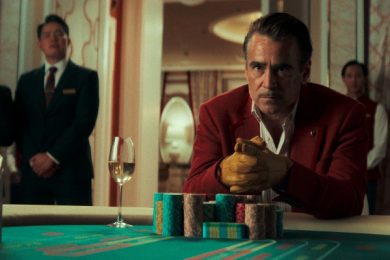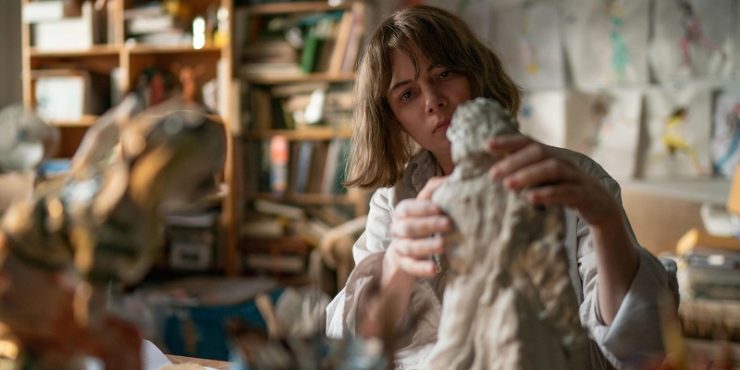The main character of Showing Up is Lizzy (played wonderfully by Michelle Williams), a sculpture artist. She has a day job doing secretarial work at her mother’s Portland art school, but finds ways to steal time for her real work: crafting clay into dainty figures with vibrant color. Like many visual artists, her pieces reflect herself and her life: beautiful but fragile, ornate visions of people attempting to exist within the chaos of everyday life. This is also a great description of the art of Showing Up‘s director, Kelly Reichardt, whose soft touch belies a complexity that radiates throughout her characters. Reichardt’s films have a evoled from the mordant slowness of Wendy and Lucy and Meek’s Cutoff into the soulful explorations of Certain Women and First Cow. Showing Up might be the best of the bunch, a melancholic glimpse at the less glamorous side of creation.
Lizzy lives in an apartment building owned by her fellow artist and frenemy, Jo (a tremendous Hong Chau). Lizzy hasn’t had hot water in her apartment for over a week, but Jo’s priorities are on her two upcoming shows. Lizzy also has a show coming soon – a fact that appears to be lost on Jo. At work, Lizzy mostly goes through her days without fanfare, even her boss/mother, Jean (Maryann Plunkett), pays her little attention. Most of the notice goes to Jo whose work is starting to get serious buzz (she might even get a catalogue!), as well as the handsome and pleasant Eric (Andre Benjamin), whose kiln helps produce many of the artists’ finished projects, including Lizzy’s. Lizzy’s father, Bill (Judd Hirsch), lives with two squatting Canadians (Amanda Plummer, Matt Malloy) whose temporary stay is getting dangerously close to permanent. Her brother, Sean (John Magaro), is a hermit who speaks in curt monosyllables if he has guests at all.
This is the atmosphere with which Lizzy must create her art. One of the charms of Showing Up is how Reichardt takes these minor key characters and morphs them into cacophonous distractions. Lizzy’s frequent indignation with their intrusions is a projection of her own insecurity in her life’s stasis. When her cat attacks a pigeon that waywardly flies into her bathroom, Lizzy tries to fling the wounded bird back out of the window. When Jo unknowingly rescues the same pigeon and bandages it, Lizzy suddenly finds herself caring for the pitiful bird. An ironic twist of fate that plays upon Lizzy’s guilt for abandoning it to begin with. With a new pet that needs to be kept desperately away from her first pet, Lizzy hunkers down to work on her sculptures in preparation for a show, meekly inviting all the same people she’s been dying to get away from.
The Northwestern setting gives Showing Up the earthy feel familiar to Reichardt’s previous films. The art school, a bohemian purgatory posing as a utopia, includes a wide array of artists of various ages and disciplines. An East Coast artist, Marlene (Heather Lawless), is visiting and shows interest in the holistic nature of the campus. She also has real admiration for Lizzy’s work, not that that makes Lizzy feel any better. A frequent source of the film’s humor is how even complements between the artists only serve to enflame rivalries and create resentment. In a community that thrives on good vibes and emphasizing that the creation is the point, Lizzy’s professional jealousies and personal vendettas feel even more petty, further entrenching her within her self-righteousness, as well as her shame.
Michelle Williams, a veteran within Reichardt’s filmography is incredible here, perfectly calibrating Lizzy’s inner crisis throughout her outer stoicism. In a world where the aloof Jo can find commercial success, the morose, modest Lizzy feels helpless and adrift. She approaches all those close to her with weary frankness, often polite but seldom friendly. Her work means the world to her but what does that mean when there’s no one to share it with? Showing Up correctly avoids histrionic sadness, trusting its brilliant ensemble to translate that through the tedium of their day-to-day lives. It’s vision of artistic expression – less a soul-bearing catharsis and more a workmanlike perseverance – feels wholly unique compared to other films about artistry. The talent behind the work is an afterthought, instead reflecting on how their lives present themselves within it.
This film really struck me. Filtered through the world of art, Showing Up is also, in its barest sense, a story about the fear of going unnoticed, of hoping your mark on the world, no matter how small, will be felt by somebody. Reichardt’s alergy to melodrama actually plays to the film’s favor. Relying on naturalism as opposed to contrived narrative, the emotional impact of Lizzy’s journey is even more effective. This is not a movie about an artist fighting to climb within a meritocracy. It’s about the various ways we declare our personhood outside of that. That everyone here happens to be artistically-inclined gives the movie a chance to witness beautiful art, even if the focus is the sweat equity that goes on behind it.
Directed by Kelly Reichardt










